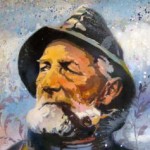
August 28, 2015
7 Tools I Use to Organize My Stories
Efriend Sacha Black interviewed author Jillian Davis and asked about the tools she used to build her story. Sacha wasn’t asking whether she used a computer or pen-and-paper, rather what literary tools-such as character profiles and timelines. I found myself nodding my head over every one Jillian mentioned.
But I wonder how many people use the sort of tools I do. When you Google pictures of writers, you often get something like this:
…or this:
I’m more this:
Let me share my writer’s tools and tell me if you do the same:
Pre-draft
I pre-draft in a spreadsheet. It’s about a dozen columns and hundreds of rows. I often rearrange the rows as a plot point changes and add rows to enhance detail. When I’m done with this pre-draft, I convert the spreadsheet to text and start the editing process.
Here’s what it looks like:
Character profiles
I fill out an extensive questionnaire on each character. I want to get to know the traits, motivations, interests that each of their friends or family would know about them. Invariably, it proves inadequate as the story unfolds and I end up looking at events through their eyes to answer the question, “What would my character really do in this situation?”
Here’s an example:
Timeline
I build this in Excel/Google Sheets so I can make it as detailed as possible. When I’m trying to find a character’s activity, I Ctrl+F (see my yellow highlights for ‘Zeke’) to find their name! Truth,it’s most beneficial when I’m setting it up as it clarifies actions and points out temporal problems. Once it’s established, it almost becomes cumbersome to use.
Support Materials
This is information I’ve collected while researching for my story. Sometimes, it’s the entire bit; other times, just a link. For my current story, it’s so long, I had to add a Table of Contents with internal links to the sections so I could find what I was looking for. A simple Ctrl+F search returned too long a list.
Here’s what it looks like for To Hunt a Sub:
Google Earth map
This was to track my character around the world as the story progressed. Often, I needed detail like:
- How long did it take to get from Point A to Point B (I measured with Google Earth’s ruler
- What’s around Point C (I zoomed in on Google Earth)
- Where was a geographic location that fits the needs of the story (for example, I was looking for a North Korean sub base–found it, thankfully in a spot that worked for my story)
- Needed the latitude and longitude of a location (Google Earth grid lines provide that
Here’s a screenshot of the Korea geographic activity in my story, mapped in Google Earth:
Pictures
So I can visualize what’s going on. Here are some I’ve used:
Cuts
I keep all the cuts from my story in case I change my mind. That happens more than I’ll admit to. For To Hunt a Sub, it’s 11 pages, size 10 font:
How about you? How do you plan and write your story?
More on writing a novel:
7 Reasons For and Three Against Critique Groups
Jacqui Murray is the author of the popular Building a Midshipman, the story of her daughter’s journey from high school to United States Naval Academy. She is the author/editor of dozens of books on integrating tech into education, webmaster for six blogs, an Amazon Vine Voice book reviewer, a columnist for Examiner.com and TeachHUB, Editorial Review Board member for Journal for Computing Teachers, monthly contributor to Today’s Author and a freelance journalist on tech ed topics.















